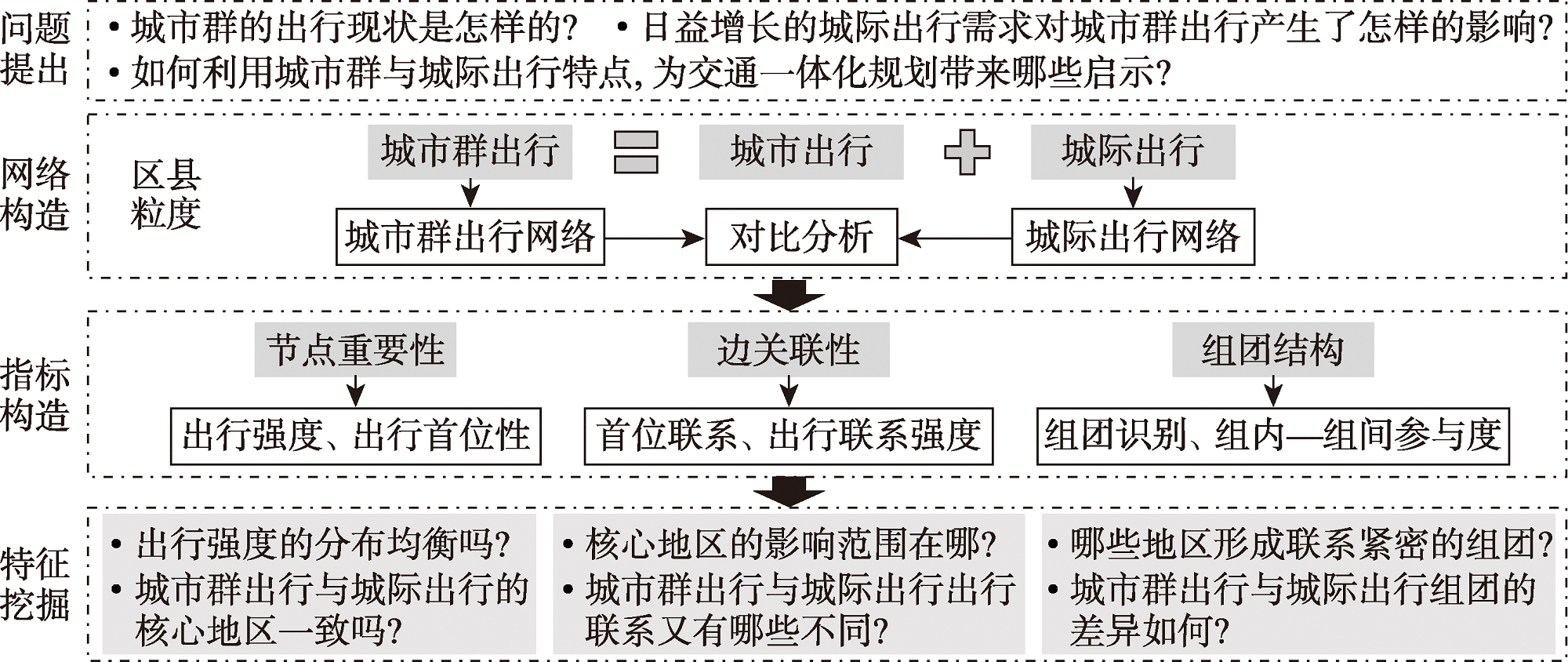

京津冀城市群总体与城际出行特征异同性挖掘
注:本文为第二十七届中国科协年会学术论文。
|
王月(1997-), 女, 博士生, 研究方向为城市交通规划与管理。E-mail: y_wang@bjtu.edu.cn |
收稿日期: 2023-05-16
修回日期: 2024-10-10
网络出版日期: 2025-04-23
基金资助
国家自然科学基金项目(52172312)
The similarities and differences in general and inter-city travel characteristics in the Beijing-Tianjin-Hebei urban agglomeration
Received date: 2023-05-16
Revised date: 2024-10-10
Online published: 2025-04-23
Supported by
National Natural Science Foundation of China(52172312)

王月 , 姚恩建 , 郝赫 , 李义罡 , 史佳柠 . 京津冀城市群总体与城际出行特征异同性挖掘[J]. 地理学报, 2025 , 80(4) : 1089 -1102 . DOI: 10.11821/dlxb202504014
The scale and spatial distribution of travel demand are crucial foundations for the formulation of transportation planning. This paper extracts the travel demand between counties and districts (referred to as counties) within the Beijing-Tianjin-Hebei (BTH) urban agglomeration based on mobile phone signaling data, and constructs travel networks for general and inter-city travels respectively. Using complex network analysis methods, it analyzes and compares the characteristics differences in node centrality, leading connections, and clustering spaces in general travels and inter-city travels within the urban agglomeration. The results indicate that: (1) The spatial distribution of travel intensities is uneven, with higher travel intensities in the center of the city, higher travel intensities for cross-boundary trips in suburban counties, and higher travel intensities for cross-city travel in border counties. The spatial distribution of travel intensities is uneven, with higher travel intensities in the center of the city, higher travel intensities for cross-boundary trips in suburban counties, and higher travel intensities for cross-city travel in border counties. (2) Travel primarily involves close connections between central urban areas and surrounding counties, with a positive correlation between city rank and travel intensity; inter-city travel is concentrated on the spillover boundaries of core cities, forming leading connection characteristics of central encirclement, boundary interaction, and enclave connections. (3) There are clear differences in the travel clusters between general travel and inter-city travel, with general travel clustering involving individual cities forming clusters; central urban areas jointly form spatially jumping inter-city clusters, with the boundary cluster centered on Beijing already in substantial scale. The differentiated regional functional positioning under different travel perspectives reveals that central urban area clusters play a regional connecting role, with the central urban areas of Beijing and Shijiazhuang simultaneously serving inter-city hub functions, yet a large number of peripheral counties participate less in travel connections. Analyzing the differentiated characteristics of general travel and inter-city travel demand among counties can clarify the transportation development positioning of different areas, providing a planning basis for the construction of a comprehensive transportation network in the urban agglomeration, thus promoting urban-rural and inter-city coordinated development.

| [1] |
[陈伟, 修春亮. 新时期城市群理论内涵的再认知. 地理科学进展, 2021, 40(5): 848-857.]
|
| [2] |
[陆大道. 《中国城市群的创新格局与路径》评介. 地理学报, 2023, 78(11): 2903.]
|
| [3] |
[宋伟轩, 徐旳, 王捷凯, 等. 基于手机画像数据的南京内城日夜间社会空间分异. 地理学报, 2024, 79(2): 421-438.]
|
| [4] |
|
| [5] |
|
| [6] |
[施响, 王士君, 王冬艳, 等. 中国市域间日常人口流动特征及影响因素. 地理科学, 2022, 42(11): 1889-1899.]
|
| [7] |
[潘竟虎, 魏石梅, 张蓉, 等. 中国居民城际出行网络的空间结构特征. 地理学报, 2022, 77(10): 2494-2513.]
|
| [8] |
[李涛, 王姣娥, 高兴川. 中国居民工作日与节假日的城际出行网络异同性研究. 地理学报, 2020, 75(4): 833-848.]
|
| [9] |
[李涛, 王姣娥, 黄洁. 基于腾讯迁徙数据的中国城市群国庆长假城际出行模式与网络特征. 地球信息科学学报, 2020, 22(6): 1240-1253.]
|
| [10] |
|
| [11] |
[王少剑, 高爽, 王宇渠. 基于流空间视角的城市群空间结构研究: 以珠三角城市群为例. 地理研究, 2019, 38(8): 1849-1861.]
|
| [12] |
[胡昊宇, 黄莘绒, 李沛霖, 等. 流空间视角下中国城市群网络结构特征比较: 基于铁路客运班次的分析. 地球信息科学学报, 2022, 24(8): 1525-1540.]
|
| [13] |
[王蓓, 刘艳华, 陈科比, 等. 京津双城联动的分析框架及要素对流特征. 地理科学进展, 2023, 42(7): 1229-1242.]
|
| [14] |
[王婧, 刘奔腾, 李裕瑞. 京津冀人口时空变化特征及其影响因素. 地理研究, 2018, 37(9): 1802-1817.]
|
| [15] |
[施澄, 田琳, 程遥. 短期人口流动视角下的长三角城市群空间组织研究: 基于手机信令数据对出行数据识别的实证. 城乡规划, 2020(6): 105-115.]
|
| [16] |
[
|
| [17] |
|
| [18] |
[李自圆, 孙昊, 李林波. 基于手机信令数据的长三角全域城际出行网络分析. 清华大学学报(自然科学版), 2022, 62(7): 1203-1211.]
|
| [19] |
[钮心毅, 岳雨峰, 李凯克. 长三角城市群中心城市与周边城市的城际出行特征研究. 上海城市规划, 2020(4): 1-8.]
|
| [20] |
[陈立峰, 尚晶, 刘婷婷, 等. 基于手机信令数据的京津冀城际出行时空特征分析. 北京交通大学学报, 2023, 47(5): 162-168.]
|
| [21] |
|
| [22] |
[安树伟, 李瑞鹏. 城市群核心城市带动外围地区经济增长了吗? 以京津冀和长三角城市群为例. 中国软科学, 2022, (9): 85-96.]
|
| [23] |
[王金营, 范世杰. 京津冀城市群空间结构特征及其演变趋势判断. 燕山大学学报(哲学社会科学版), 2023, 24(5): 68-80.]
|
| [24] |
[赵静湉, 陈彦光, 李双成. 京津冀城市用地形态的双分形特征及其演化. 地理科学进展, 2019, 38(1): 77-87.]
|
| [25] |
[龙玉清, 陈彦光. 基于灯光数据的京津冀城市多标度异速分析. 地理科学进展, 2019, 38(1): 88-100.]
|
| [26] |
|
| [27] |
[赵鹏军, 胡昊宇, 曾良恩, 等. 重探城市群地区跨城移动性的引力模型. 中国科学: 地球科学, 2023, 53(2): 256-266.]
|
| [28] |
|
| [29] |
[赵构恒, 贾鹏, 周安民. 有向加权网络中的改进度中心性. 计算机应用, 2020, 40(S1): 141-145.]
|
| [30] |
|
| [31] |
|
| [32] |
|
| [33] |
|
| [34] |
|
| [35] |
[丁亮, 钮心毅, 宋小冬. 基于个体移动轨迹的多中心城市引力模型验证. 地理学报, 2020, 75(2): 268-285.]
|
/
| 〈 |
|
〉 |